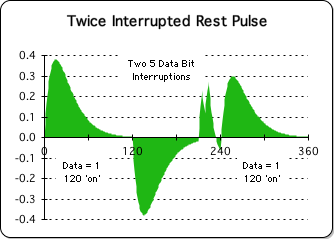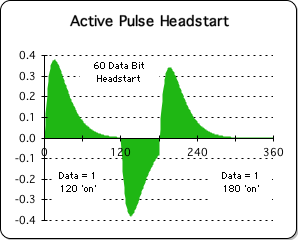Tantalizing Questions
The Triple Pulse & Sleep? What correspondences could there possibly be between a purely mathematical construct and a daily experience that is more regular than eating? Will the correspondences hold water? Or are they as leaky as an old faucet … or an old brain? What could a mathematical model, the Triple Pulse, possibly have to say about the behavioral reality of Sleep Deprivation? On a more theoretical level, how could abstract mathematics hope to correspond with human behavior?
Original Inference from the ideal Triple Pulse
Inferences must stick to the mathematical facts of the model.
In the previous article we explored the Results of the Triple Pulse Experiment. In the following article, we will investigate how these results correspond with experimental reality. To avoid straying into unsupported bar room speculation, it is essential to restrain any impulse to make over-reaching inferences from these facts. As Uncle Gene, a chairman of the Biology Department at North Carolina State, cautions: “Don’t step out on a theoretical limb. One step away from the facts and you’re likely to be wrong.”
The Triple Pulse results are Pure Mathematics.
To generate the ideal Triple Pulse, the Living Algorithm digests a specific sequence of numbers – 120 1s, 120 0s, 120 1s (in that exact order). This precise sequence enables each pulse – Active and Rest – to attain its maximum amplitude (peak) and area. These ideal dimensions are the direct result of an ideal relationship between the pulses. A powerful mathematical relationship between the pulses exists. It is indicated by the fact that a Rest Pulse is necessary in order to refresh the Active Pulse. Conversely, the Rest Pulse depends upon a preceding Active Pulse for its mere existence. Without a preceding Active Pulse, there is no Rest Pulse at all. This mathematical relationship is one compelling message of the Triple Pulse.
Original Theory: ‘Breaks necessary to maximize creative output.’
The Author’s initial response to this intriguing and inherent mathematical process was to examine his own personal experience. He inferred that his own creative sessions might benefit by taking a complete break from the activity. He reasoned that continuing to focus on the project without taking a significant break might very well be counterproductive.
Personal Experience confirmed Prediction
He tested this idea with a simple personal experiment. Once his creative session was finished, the Author made a deliberate attempt to clear his mind of the project. Previously, his natural tendency was to continue dwelling upon elements of the project far after the session had concluded. The results of this personal experiment confirmed the inference he had made from the Living Algorithm’s mathematical model. By taking a complete break, he did, in fact, feel more refreshed when undertaking his next creative session. This experience supported a connection between rest cycles and activity cycles in both human behavior and the Triple Pulse.
Initial Inferences from the Triple Pulse Experiment
The Author’s initial inference was the result of examining the ideal Triple Pulse relationship. But, what happens when we tamper with the number sequence that produces the ideal Triple Pulse? Answering this question was the focus of the Triple Pulse Experiment. There were two parts to this study. Let's review the results of each part.
Experimental Results: Interruptions to the Rest Pulse
Two 5-minute Interruptions -> 20% Reduction

In the first part we studied interruptions during the Rest Pulse. We began by introducing a single ‘5-minute’ interruption into the Rest Pulse. The results were clear. The following Active Pulse was diminished in its ideal dimensions – both peak and area were negatively affected. The ‘experiment’ (a set of computer trials) was designed to find the sectors of greatest impact. We found that when the Rest Pulse is 'twice-interrupted' at a specific time, the impact on the following Active Pulse reaches its maximum – a reduction of over 20% (shown at right).
Experimental Results: the Head start Experiment
60-minute Head start -> 20% Reduction

In the second set of Triple Pulse ‘experiments’, we started the final Active Pulse of 1s before the Rest Pulse of 0s had come to its 'natural end’. If we associate the Rest Pulse of 0s with ‘sleep time’ and the following Active Pulse of 1s with ‘awake’ time, this could be viewed as akin to cutting one’s sleep short to get a head start on the day. Hence, the name of the experiment. Let’s look at the graph and see what happens. The results are clear. Notice that a '60 data bit’ head start, at the expense of the ‘sleep’ cycle (the Rest Pulse), diminishes both the area and peak of the ensuing ‘activity’ cycle (the final Active Pulse).
Inference: 'Interrupted Sleep' impairs Potentials of the following Day
Initially, it was thought that the Active Pulses represented creative or productive sessions. As the years passed, it became apparent that the relationship between the Active and Rest Pulses seemed to mimic the relationship between waking and sleeping. As such, the Triple Pulse could be thought to represent the daily alternation of the conscious and unconscious states. In this context, the results of the experiment clearly implied that interruptions to the sleep cycle significantly reduced the potentials (productivity, creativity) for the following day.
Inference: Shortened Sleep Cycle impairs Output Potentials of following Day
If the alternation of the Active and Rest Pulses mimics the alternation of sleep and waking, as supposed, the implications of these presumed associations are clear. When sleep is cut short to provide extra work time in the day, one’s actual productivity does not reflect that advantage. In fact, the day’s potentials are reduced. A potentially broader implication would suggest that a sleep-deprived nation is not operating at peak efficiency.
Experimental Evidence for Harm of Sleep Deprivation
Personal Perception of Sleep Deprivation’s Harm
The Author’s experience certainly provided evidence for the applicability of the Triple Pulse computer experiments. The Author immediately noticed a correspondence between the model's behavior and his experience as a father of small children. His personal perception was clear. Sleep deprivation harmed his cognitive abilities. (Our condolences to new parents.)
Which Mental Faculty does Sleep Deprivation dim?
While the results and presumed correspondences of the Triple Pulse Experiment with sleep reality are interesting, they have, as yet, no scientific validity. The final Active Pulse of 1s is certainly diminished, but what is its correspondence, if any, with reality? Would experimentation establish that there is only a limited, but tightly defined correlation, between the Triple Pulse and Sleep Deprivation? If so, which of our many mental capacities did the deprivation affect? Only the tightly defined experiments recorded in the scientific literature - journal articles, books, summations, and such - could determine the actual parameters of the presumed linkage.
Experimental Evidence
Is there any experimental evidence that sleep deprivation has a detrimental effect on mental performance?
Definitely. There are innumerable studies demonstrating the negative linkage between sleep deprivation and performance. In his best selling book brain rules Dr. Medina, a scientific insider, confirmed the Author’s initial sense that a foggy brain was a result of a child crying in the night. In fact, Dr. Medina’s review of the scientific literature indicates that the consequences are dramatic:
"The bottom line is that sleep loss means mind loss. Sleep loss cripples thinking in just about every way you can measure thinking. Sleep loss hurts attention, executive function, immediate memory, working memory, mood, quantitative skills, logical reasoning ability, general math knowledge. Eventually, sleep loss affects manual dexterity, including fine motor control … , and even gross motor movements, such as the ability to walk on a treadmill." (brain rules, p. 163)
Sleep deprivation, not interruptions or lack of energy, diminishes day's potentials
The mathematical implications of the Triple Pulse Experiment do indeed appear to be confirmed by a wide range of experimental evidence. In both Triple Pulse experiments only the Rest Pulse is interrupted or shortened (deprived). The following Active Pulse is not subject to any interruptions whatsoever. Nonetheless, interruptions in the Rest Pulse diminish both the peak and area of the final Active Pulse. Similarly, in scientific experiments only 'sleep' time is interrupted or shortened. Aside from sleep loss, the individual's body and mind remain the same. Yet when his sleep cycle is deprived, the individual's cognitive abilities for the following day are diminished.

Parallels: Rest Pulse <=> Sleep; Active Pulse <=> Cognitive Abilities
The parallels are striking. The Rest Pulse corresponds with an individual’s ‘sleep time’, and the subsequent Active Pulse corresponds with the following day’s cognitive abilities. With these correspondences in mind, both the mathematical model and sleep deprivation studies arrive at the same conclusion: interrupting or shortening the ‘rest’/sleep cycle inevitably damages the potentials of the following cycle. One theme of the Triple Pulse model is emerging: there is no substitute for an uninterrupted Rest Pulse. The implications of the Triple Pulse Experiment go far beyond the number 3. The relationship described in these experiments suggest the possibility that periods of ‘activity’ and ‘rest’ follow each other in an endless cycle - each nourishing the other in alternate succession.
What Mechanism links the Triple Pulse to Sleep Deprivation?
Just a coincidence?
The above correspondence between the Triple Pulse, a mathematically generated model, and the Sleep Deprivation phenomenon described in the scientific literature evokes some tantalizing questions. If there is a correspondence, does it go beyond mere coincidence? The strength of the correspondence we have described suggests to us that more than coincidence is at work here. If this correspondence is more than mere coincidence, then we begin to inquire about the nature of the presumed connection.
Is the explanation for the linkage traditional or perhaps mathematical?
Is there an, as yet, unidentified factor that links the mathematical model with the well-documented effects of sleep deprivation? For instance, does the Triple Pulse actually reflect a physical, bio-chemical, neurological or psychological mechanism? What other options could there be? Consider the possibility that our method of digesting information may be fundamentally a mathematical phenomenon. What if the mathematics of the Triple Pulse captures this method of digesting information, and consequently, dictates the empirical harm of sleep loss?
For plausible answers, more investigation is required.
In the preceding paragraph, we commented on the strength of the correspondence between mathematics and human behavior. Some readers might find this conclusion a bit hasty. Our conclusion that more than coincidence is responsible for the presumed linkages between sleep loss and the Triple Pulse requires a deeper investigation. Will the entire model fall apart upon closer examination? Validation from other perspectives should increase our confidence in this theoretical connection. To confirm additional correlations between the Triple Pulse model (a purely mathematical construct) and the scientific reality surrounding sleep, check out the next article in this sequence: The Triple Pulse & the Necessity of Sleep.
If you wonder how the Author came up with his mathematical model and why he decided to share it, check out The Surprising Emergence of the Triple Pulse.
If you wonder how the relationship between Life and the Living Algorithm is progressing, check out, Life: "Is there more evidence for Sleep/Triple Pulse connection?"